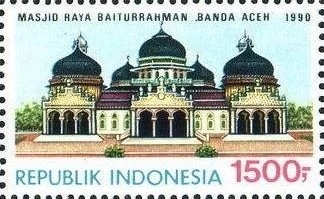Baiturrahman Grand Mosque in Aceh, Indonesia










Standing majestically in the heart of Banda Aceh, the Baiturrahman Grand Mosque represents far more than a place of worship. It embodies the resilient spirit of Aceh and serves as a powerful symbol of Islam in Indonesia. This magnificent mosque, known locally as Masjid Raya Baiturrahman, has witnessed centuries of history, survived natural disasters, and continues to be a beacon of faith for Muslims across the archipelago and beyond.
Historical Significance and Cultural Importance
The Baiturrahman Mosque holds an extraordinary place in Indonesian Islamic history, tracing its origins back to the 12th century during the reign of Sultan Alauddin Mahmudsyah of the Aceh Sultanate. Originally constructed as a modest wooden structure, the mosque became the spiritual center of what was then one of the most powerful Islamic kingdoms in Southeast Asia. Aceh, often referred to as the "Veranda of Mecca," served as the first point of entry for Islam into the Indonesian archipelago, making this mosque a crucial landmark in the spread of the faith throughout the region.
Throughout its long history, the mosque has served multiple roles beyond its primary function as a place for Muslims to pray. It functioned as a center of Islamic learning, a gathering place for community leaders, and a symbol of Acehnese independence and identity. The mosque's importance grew during the Dutch colonial period, when it became a focal point for resistance movements and a place where Islamic scholars would gather to discuss both religious and political matters.
The mosque's resilience mirrors that of the Acehnese people themselves. It has been rebuilt and expanded numerous times following earthquakes, wars, and other disasters. Most notably, the mosque survived the devastating 2004 Indian Ocean tsunami that claimed over 170,000 lives in Aceh province alone. While the surrounding area was completely destroyed, the mosque remained standing, leading many to view it as a divine miracle and a symbol of hope amid tragedy.
Architectural Marvel Through the Ages
The current structure of Baiturrahman Mosque is the result of multiple renovations and expansions, each reflecting the architectural styles and influences of different eras. The mosque showcases a unique blend of traditional Acehnese Islamic architecture with influences from Moorish, Indian, and modern Islamic design elements.
The mosque's most striking feature is its collection of minarets. The current complex boasts seven elegant minarets, each standing tall as testament to the mosque's grandeur. These minarets are not merely decorative; they serve the practical purpose of calling Muslims to prayer five times daily, their calls echoing across the city of Banda Aceh. The black domes, a distinctive feature of the mosque, create a dramatic silhouette against the sky and represent a departure from the more common golden or white domes found in many other Indonesian mosques.
The main prayer hall can accommodate thousands of worshippers, featuring soaring ceilings adorned with intricate Islamic calligraphy and geometric patterns. The interior design emphasizes both functionality and beauty, creating a space that inspires contemplation and spiritual connection. Traditional Islamic architectural elements such as pointed arches, decorative mihrab (prayer niche), and ornate columns blend seamlessly with modern construction techniques and materials.
One of the most remarkable aspects of the mosque's architecture is its earthquake-resistant design, implemented after previous structures were damaged by seismic activity. The current building incorporates modern engineering principles while maintaining its traditional Islamic aesthetic, ensuring that future generations of Muslims will have a safe and beautiful place to pray and gather.
A Living Symbol of Faith and Community
Today, the Baiturrahman Grand Mosque serves as the primary place of worship for Banda Aceh's Muslim population and attracts visitors from across Indonesia and the Islamic world. During Friday prayers, the mosque fills with thousands of worshippers, creating a powerful display of communal faith and devotion. The mosque is particularly crowded during Islamic holy months such as Ramadan, when special evening prayers called Tarawih draw large congregations.
The mosque plays a vital role in preserving and promoting Islamic culture and education in Aceh. It houses a religious school where young Muslims learn to recite the Quran and study Islamic theology. The mosque also serves as a venue for religious ceremonies, including weddings and other important life events, cementing its role at the center of community life.
Beyond its religious functions, the mosque has become an important cultural and tourist destination. Visitors come not only to pray but also to admire the architecture, learn about Islamic history in Indonesia, and experience the spiritual atmosphere that permeates the complex. The mosque's survival of the 2004 tsunami has made it a symbol of divine protection and human resilience, inspiring pilgrims and tourists alike.
Preserving Heritage for Future Generations
The Baiturrahman Grand Mosque represents the enduring strength of Islam in Indonesia and the particular character of Acehnese Islamic culture. As Indonesia's westernmost province and the region where Islam first took root in the archipelago, Aceh maintains a special relationship with the Islamic world, and this mosque serves as a tangible link to that heritage.
The ongoing maintenance and occasional renovations of the mosque demonstrate the community's commitment to preserving this sacred space for future generations of Muslims. Each restoration project aims to maintain the mosque's historical character while incorporating necessary modern improvements for safety and accessibility.
The Baiturrahman Grand Mosque stands as more than just a building; it is a living testament to the faith, resilience, and cultural identity of the Acehnese people. For Muslims visiting Aceh, whether for pilgrimage, tourism, or business, the mosque offers not only a place to fulfill their obligation to pray but also an opportunity to connect with the deep Islamic roots that define this remarkable corner of Indonesia. In a rapidly changing world, the Baiturrahman Mosque remains a constant reminder of the eternal values and spiritual traditions that continue to guide and inspire the Muslim community in Aceh and beyond.